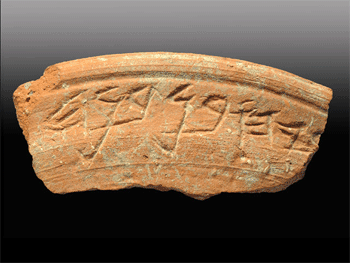Archaeological Discoveries: 2,700 Year Old Inscribed Pottery Shard Found in Jerusalem
(August 2013)
Archaeological excavations conducted by the Israel Antiquities Authority in the area of the Gihon Spring in the City of David, in the Walls around Jerusalem National Park, have unearthed a layer of rich finds including thousands of broken pottery shards, clay lamps and figurines.
Most intriguing is the discovery of a ceramic bowl with a partially preserved inscription in ancient Hebrew. While not complete, the inscription likely presents the name of a seventh century BCE figure, as it resembles other names known from both the Biblical and archaeological record. It therefore provides a connection to the people living in Jerusalem at the end of the First Temple period.
The most similar name to the inscription is Zechariah son of Benaiah, the father of the Prophet Jahaziel. The name Zechariah son of Benaiah appears in 2 Chronicles 20:14 where it states that Jahaziel, son of Zechariah, son of Benaiah, a Levite of the sons of Asaph, prophesized before the Biblical King Jehoshaphat before the nation went off to war against the ancient kingdoms of Ammon and Moab.
Israel Antiquity Authority archaeologists Dr. Joe Uziel and Nahshon Zanton, who discovered the bowl while excavating remains associated with the First Temple period destruction, explained that the letters inscribed on the shard likely date to the 8-7th centuries BCE, placing the production of the bowl sometime between the reign of Hezekiah and the destruction of Jerusalem under King Zedekiah. The archaeologists also explained that the inscription was engraved on the bowl prior to firing, indicating that the inscription originally adorned the rim of the bowl in its entirety, and was not written on a shard after the vessel was broken.
While the purpose of the inscription on the bowl is unclear, archaeologists have posited that the bowl may have contained an offering, likely given by the individual whose name was inscribed on the bowl, or alternatively given to him.
Sources: Israel Ministry of Foreign Affairs (August 19, 2013); Photo courtesy of the Israel Antiquities Authority



